It looks like you're using an Ad Blocker.
Please white-list or disable AboveTopSecret.com in your ad-blocking tool.
Thank you.
Some features of ATS will be disabled while you continue to use an ad-blocker.
35
share:
What is zodiacal light?
The Zodiacal light is composed of fine particles of dust in orbit around the sun and is visible because of scattered sunlight from the particles. The glow is brightest toward the sun from particles with diameters between a couple of micrometers and a few millimeters.
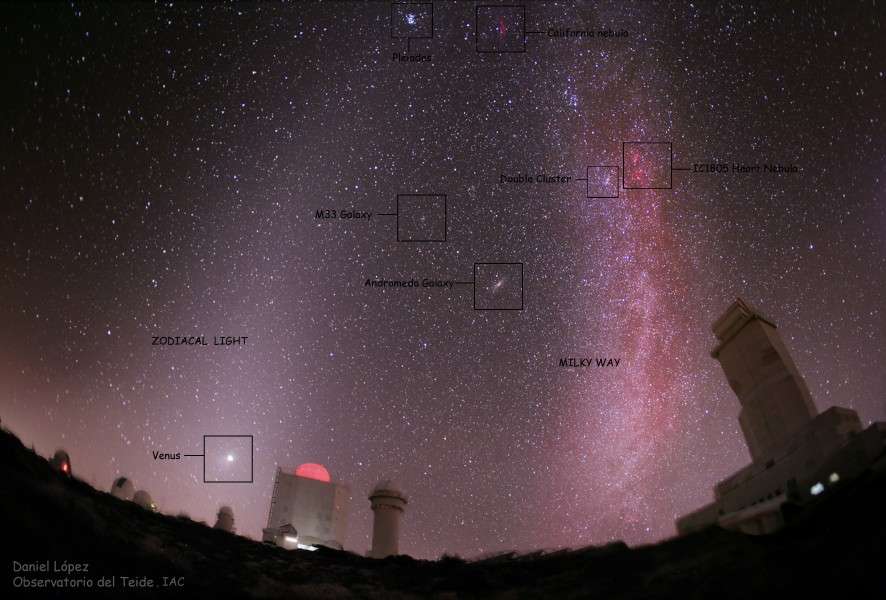
Two fundamental planes of planet Earth's sky compete for attention in this remarkable wide-angle vista, recorded on January 23rd. Arcing above the horizon and into the night at the left is a beautiful band of Zodiacal Light - sunlight scattered by dust in the solar system's ecliptic plane. Its opponent on the right is composed of the faint stars, dust clouds, and nebulae along the plane of our Milky Way Galaxy. Both celestial bands stand above the domes and towers of the Teide Observatory on the island of Tenerife. Also out to play in the pristine, dark skies over the Canary Islands, are brilliant Venus (lower left), the distant Andromeda Galaxy (near center), and the lovely Pleiades star cluster (top center). Of course, seasoned skygazers might even spot M33, the California Nebula, IC1805, and the double star cluster of Perseus. (Need some help? Just slide your cursor over the picture.)
SOURCE: APOD2009
From the mid-northern latitudes, the Zodiacal light is most easily visible from a dark location under clear and transparent skies just after evening twilight in the west in February and March, and in the morning eastern sky, just before the start of twilight in October. It is best seen at these times because the plane of dust that comprises it lies in the same plane as the ecliptic, and the ecliptic is at it's steepest angle to the horizon at these times of the year.
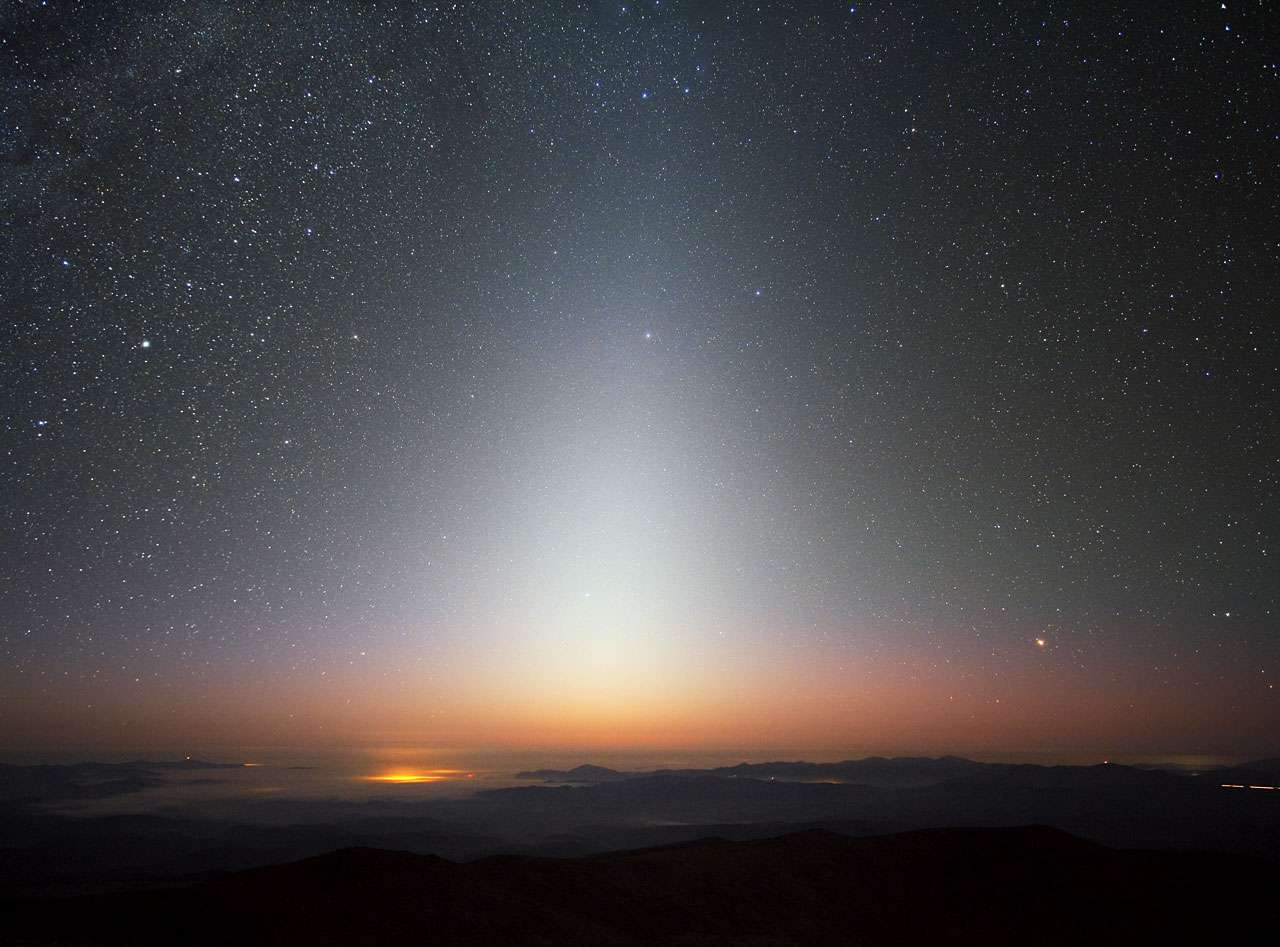
This image beautifully captures the zodiacal light, a triangular glow seen best in night skies free of overpowering moonlight and light pollution. The photograph was taken at ESO’s La Silla Observatory in Chile in September 2009, facing west some minutes after the Sun had set. A sea of clouds has settled in the valley below La Silla, which sits at an altitude of 2400 metres, with lesser peaks and ridges poking through the mist.
SOURCE: ESO
Many people confuse the Zodiacal light with twilight since it occurs in roughly the same area of sky, although careful attention to the time of the true end of astronomical twilight will remove any doubt about whether you are seeing the Zodiacal light or the sky brightening from lingering twilight.
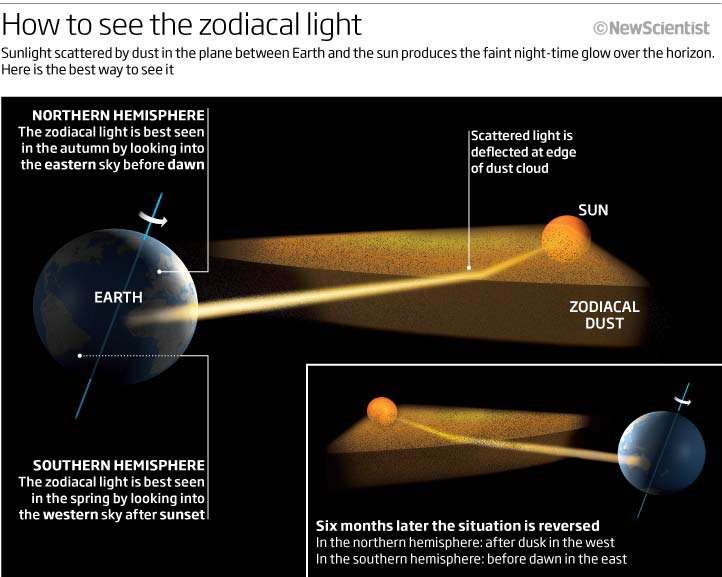
SOURCE: APOD Forum
Since the band of dust that forms the Zodiacal light completely circles the sun, it actually stretches across the entire night sky. At the anti-solar point, that point in the sky exactly opposite the sun in the sky, lies a very subtle, and very faint brightening of the dust called the Gegenschein, which is German for "counter-glow". Due to a phase effect similar to the increased brightness of the full moon, this brightening may also be helped by a concentration of dust at the L3 Lagrangian point. The Gegenschein is connected to the Zodiacal light by an even fainter portion of the dust called the Zodiacal bridge or band, and is extremely difficult to see. The Gegenschein is most easily seen at midnight when it is highest in the sky, and in those times of the year when it is in a part of the sky with few stars from late September to early November in Pices, and from late January to early February in Cancer.
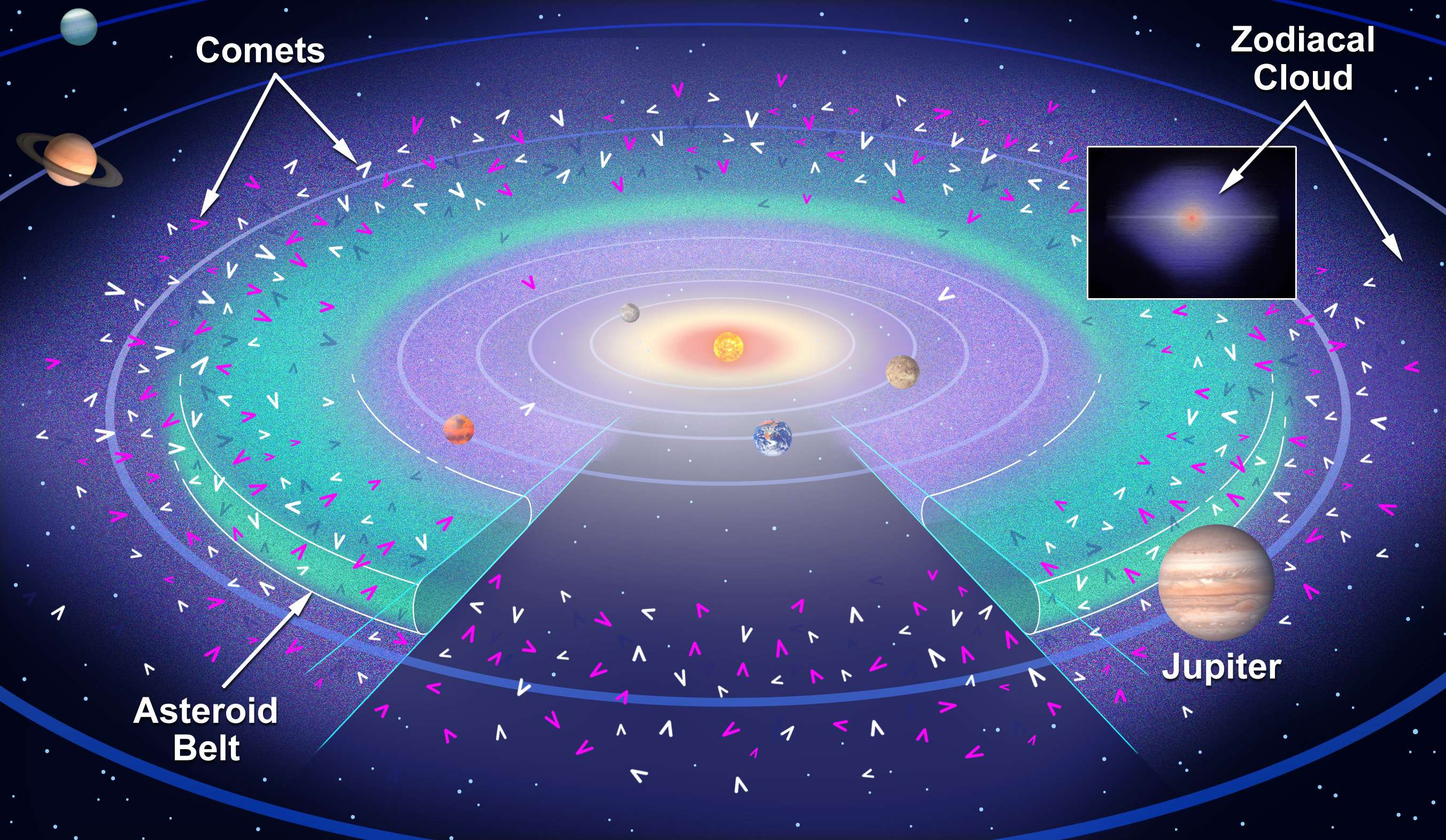
The dust between the planets, that scatters sunlight our way, is not from the asteroid belt (green), but from periodic comets that spend much of their time near the orbit of Jupiter. (Credit: SWRI/SETI (Andrew Blanchard, David Nesvorny and Peter Jenniskens))
SOURCE: APOD Forum
Interestingly, the Zodiacal light and Gegenschein can only be seen with the unaided eye, and not through any optical instruments such as binoculars or telescopes because of it's large size and low surface brightness. Parts of this cloud of interplanetary dust are also visible when the larger particles enter the Earth's atmosphere as meteors.
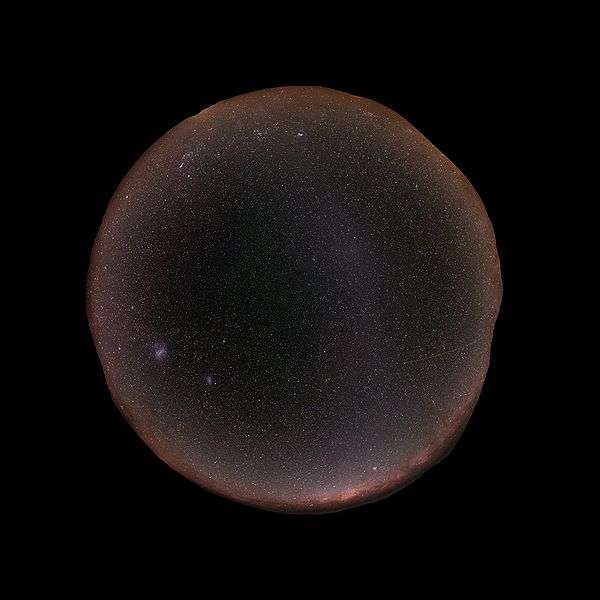
Like the zodiacal light, the gegenschein is sunlight reflected by interplanetary dust. Most of this dust is orbiting the Sun in about the ecliptic plane, with a possible concentration of particles at the L2 Earth–Sun Lagrangian point.
It is distinguished from zodiacal light by its high angle of reflection of the incident sunlight on the dust particles. It forms a slightly more luminous, oval glow directly opposite the Sun within the band of luminous zodiacal light. The intensity of the gegenschein is (relatively) enhanced because each dust particle is seen in full phase.
SOURCE: Wiki
Stunning views of the zodiacal light:
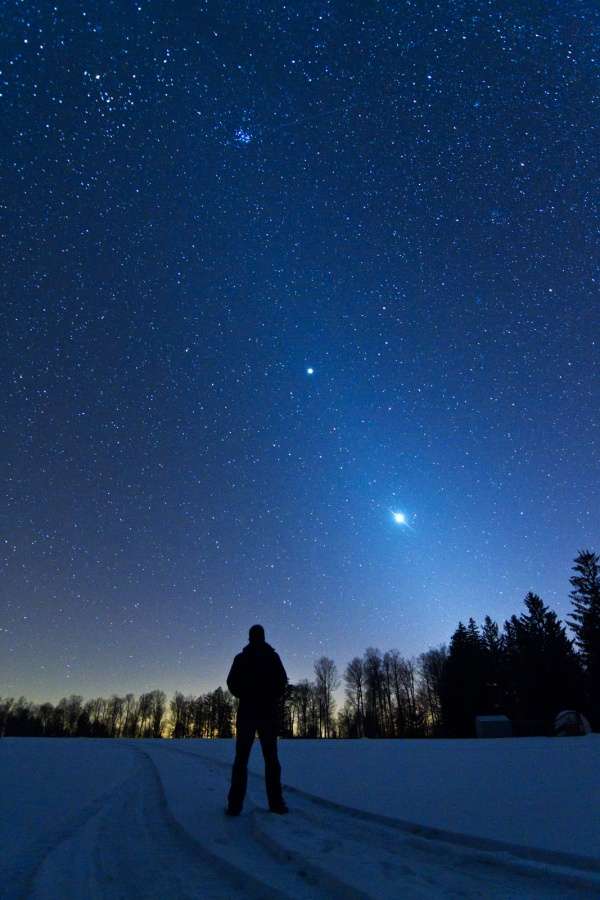
SOURCE: APOD today
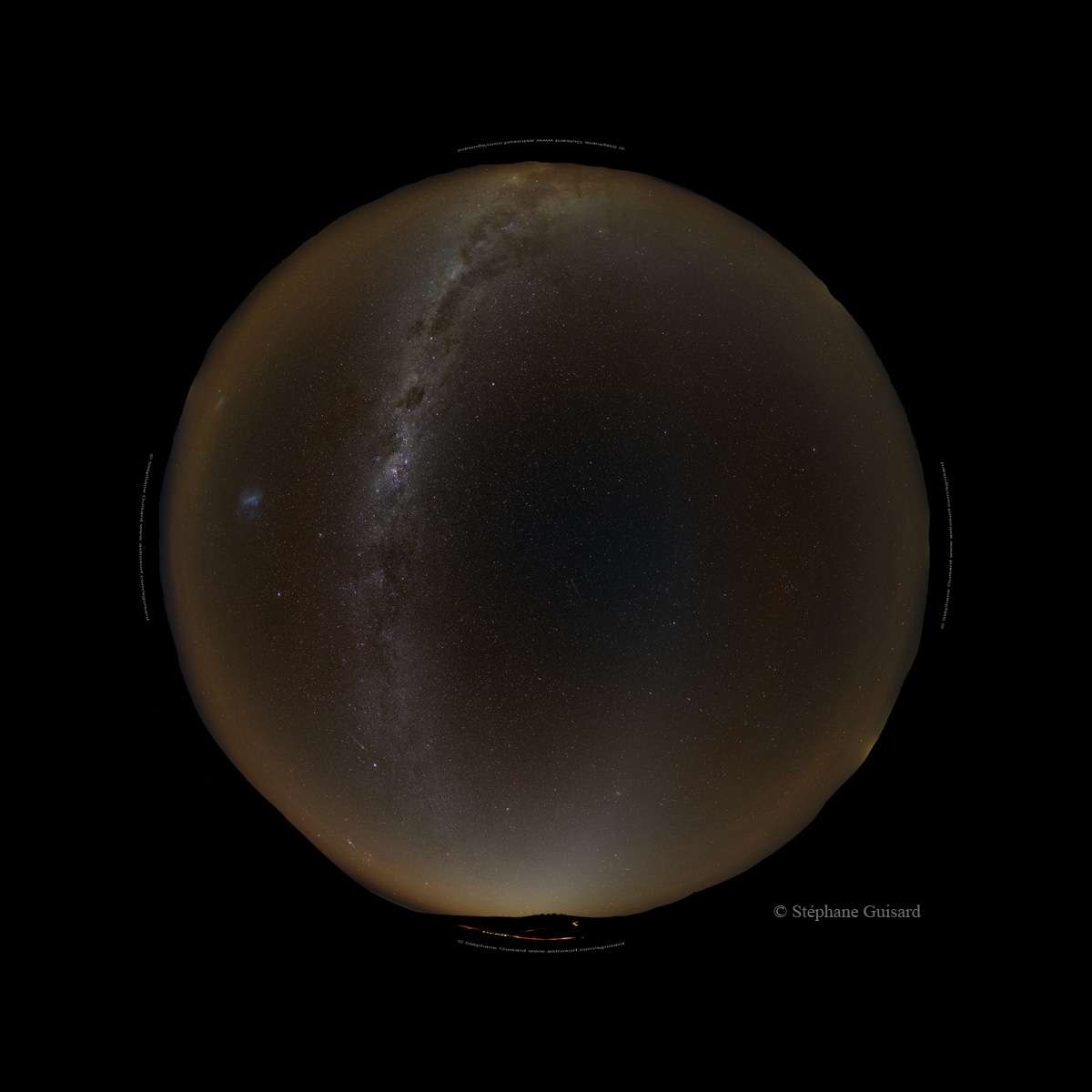
SOURCE: Stéphane Guisard from Astrosurf
Note: the last link above really worth a visit as you can see hi resolution pictures of the zodiacal light, in all sky fish eye view, with the constellations lines and names, as well as a 360° panoramic view with Paranal Observatory, Orion, Big deeper, Scorpius, Milky Way and zodiacal light.
Another SOURCE: Astropix

Zodiacal light Google mozaic
The Zodiacal light is composed of fine particles of dust in orbit around the sun and is visible because of scattered sunlight from the particles. The glow is brightest toward the sun from particles with diameters between a couple of micrometers and a few millimeters.

Two fundamental planes of planet Earth's sky compete for attention in this remarkable wide-angle vista, recorded on January 23rd. Arcing above the horizon and into the night at the left is a beautiful band of Zodiacal Light - sunlight scattered by dust in the solar system's ecliptic plane. Its opponent on the right is composed of the faint stars, dust clouds, and nebulae along the plane of our Milky Way Galaxy. Both celestial bands stand above the domes and towers of the Teide Observatory on the island of Tenerife. Also out to play in the pristine, dark skies over the Canary Islands, are brilliant Venus (lower left), the distant Andromeda Galaxy (near center), and the lovely Pleiades star cluster (top center). Of course, seasoned skygazers might even spot M33, the California Nebula, IC1805, and the double star cluster of Perseus. (Need some help? Just slide your cursor over the picture.)
SOURCE: APOD2009
From the mid-northern latitudes, the Zodiacal light is most easily visible from a dark location under clear and transparent skies just after evening twilight in the west in February and March, and in the morning eastern sky, just before the start of twilight in October. It is best seen at these times because the plane of dust that comprises it lies in the same plane as the ecliptic, and the ecliptic is at it's steepest angle to the horizon at these times of the year.

This image beautifully captures the zodiacal light, a triangular glow seen best in night skies free of overpowering moonlight and light pollution. The photograph was taken at ESO’s La Silla Observatory in Chile in September 2009, facing west some minutes after the Sun had set. A sea of clouds has settled in the valley below La Silla, which sits at an altitude of 2400 metres, with lesser peaks and ridges poking through the mist.
SOURCE: ESO
Many people confuse the Zodiacal light with twilight since it occurs in roughly the same area of sky, although careful attention to the time of the true end of astronomical twilight will remove any doubt about whether you are seeing the Zodiacal light or the sky brightening from lingering twilight.

SOURCE: APOD Forum
Since the band of dust that forms the Zodiacal light completely circles the sun, it actually stretches across the entire night sky. At the anti-solar point, that point in the sky exactly opposite the sun in the sky, lies a very subtle, and very faint brightening of the dust called the Gegenschein, which is German for "counter-glow". Due to a phase effect similar to the increased brightness of the full moon, this brightening may also be helped by a concentration of dust at the L3 Lagrangian point. The Gegenschein is connected to the Zodiacal light by an even fainter portion of the dust called the Zodiacal bridge or band, and is extremely difficult to see. The Gegenschein is most easily seen at midnight when it is highest in the sky, and in those times of the year when it is in a part of the sky with few stars from late September to early November in Pices, and from late January to early February in Cancer.

The dust between the planets, that scatters sunlight our way, is not from the asteroid belt (green), but from periodic comets that spend much of their time near the orbit of Jupiter. (Credit: SWRI/SETI (Andrew Blanchard, David Nesvorny and Peter Jenniskens))
SOURCE: APOD Forum
Interestingly, the Zodiacal light and Gegenschein can only be seen with the unaided eye, and not through any optical instruments such as binoculars or telescopes because of it's large size and low surface brightness. Parts of this cloud of interplanetary dust are also visible when the larger particles enter the Earth's atmosphere as meteors.

Like the zodiacal light, the gegenschein is sunlight reflected by interplanetary dust. Most of this dust is orbiting the Sun in about the ecliptic plane, with a possible concentration of particles at the L2 Earth–Sun Lagrangian point.
It is distinguished from zodiacal light by its high angle of reflection of the incident sunlight on the dust particles. It forms a slightly more luminous, oval glow directly opposite the Sun within the band of luminous zodiacal light. The intensity of the gegenschein is (relatively) enhanced because each dust particle is seen in full phase.
SOURCE: Wiki
Stunning views of the zodiacal light:

Venus and Jupiter are this month's two brightest planets. Shortly after sunset on February 20, they dominate the sky above the western horizon and this snowy landscape. In clear and transparent skies over Cherry Springs State Park, Pennsylvania, USA, they are also seen immersed in Zodiacal light. The extended, diffuse, triangular glow is sunlight scattered by dust along the plane of the ecliptic. Brighter near the horizon, the Zodiacal glow angles upward, first to Venus and then to Jupiter hugging the ecliptic as they orbit the Sun.
Fading even further, the glow stretches toward the lovely Pleides star cluster near the top of the frame. Following their appearance in this Zodiacal skyscape, the coming days will see Venus and Jupiter sharing the early evening sky with a young crescent Moon. The two bright planets are even headed for a close pairing or conjunction, separated by about 3 degrees on March 13.
SOURCE: APOD today

SOURCE: Stéphane Guisard from Astrosurf
Note: the last link above really worth a visit as you can see hi resolution pictures of the zodiacal light, in all sky fish eye view, with the constellations lines and names, as well as a 360° panoramic view with Paranal Observatory, Orion, Big deeper, Scorpius, Milky Way and zodiacal light.
Another SOURCE: Astropix

Zodiacal light Google mozaic
edit on 23-2-2012 by elevenaugust because: add sources
Your posts are always breathtakingly beautiful and fully informative. I hope you realize you are appreciated
Originally posted by Iamschist
Your posts are always breathtakingly beautiful and fully informative. I hope you realize you are appreciated
Thank you very much, Iamschist!
I always try to do my best and to be as educational as possible, as, most of the time we are surrounded by natural unknown wonders.
edit on
23-2-2012 by elevenaugust because: (no reason given)
How beautiful!
Awsome post. Reminds me of why i moved out to the sticks.
Awsome post. Reminds me of why i moved out to the sticks.
reply to post by elevenaugust
Thanks for this very informative thread and the gorgeous picture's.
Appreciated for all the work and time you put into this thread.
Keep up the good work
Thanks for this very informative thread and the gorgeous picture's.
Appreciated for all the work and time you put into this thread.
Keep up the good work
I didn't even know there was a such thing as zodiacal light.
S&F for showing me something i didn't know.
S&F for showing me something i didn't know.
ATS is really lucky to have you posting all these wonderful threads. Threads that constantly and consistently inform and enlighten us all, that have
made my day many times over now!
I often wish to have lived 200 years ago where possibly most of the populous would have known the heavens far more intimately than we do today. Sure we have wonderful tech to bring these images to our little computers in our light polluted cities, but to have a celestial IMAX experience year round as your entertainment would have been wonderful.
(Not that I dont appreaciate the beauty we get to see now of course, in fact, its a subject of endless beauty)
Thank you deeply as always elevenaugust! (ats, should be paying you!)
I often wish to have lived 200 years ago where possibly most of the populous would have known the heavens far more intimately than we do today. Sure we have wonderful tech to bring these images to our little computers in our light polluted cities, but to have a celestial IMAX experience year round as your entertainment would have been wonderful.
(Not that I dont appreaciate the beauty we get to see now of course, in fact, its a subject of endless beauty)
Thank you deeply as always elevenaugust! (ats, should be paying you!)
reply to post by Qumulys
You still can have the full IMAX experience... just buy some tickets and come to the north of Chile, the most clear skies in the world.
Even in the south, where there's no luminic pollution you can have it... I haven't visited the north yet, but it seems to be wonderful by night (and so freaking cold too).
I had several "astrorgasms" when visiting a friend at Temuco's countryside... jesus... christ. It seemed like the stars were going to fall over your head in any minute!
You still can have the full IMAX experience... just buy some tickets and come to the north of Chile, the most clear skies in the world.
Even in the south, where there's no luminic pollution you can have it... I haven't visited the north yet, but it seems to be wonderful by night (and so freaking cold too).
I had several "astrorgasms" when visiting a friend at Temuco's countryside... jesus... christ. It seemed like the stars were going to fall over your head in any minute!
I seriously wish I could be there to personally witness what we captured in that first image...
It would be magical...and make me feel so small.
It would be magical...and make me feel so small.
Beautiful! I cannot remember the last time I saw a night sky even half as filled with stars as these images.
reply to post by elevenaugust
Nice pictures very cool. I love the one of the guy standing in a snowy field looking up at the sky.
U
Nice pictures very cool. I love the one of the guy standing in a snowy field looking up at the sky.
U
That is an amazing photo!
Thanks for posting that.
The thing I miss most about being from a small town is I can't see most of the night sky anymore.
Thanks for posting that.
The thing I miss most about being from a small town is I can't see most of the night sky anymore.
Originally posted by Pigraphia
That is an amazing photo!
Thanks for posting that.
The thing I miss most about being from a small town is I can't see most of the night sky anymore.
Thanks!
Yes, the real shame is that in our big cities, we can't see the beauty of the night sky anymore.
Anyway, things are changing, at least here in France, as we begin to use directional lightning:
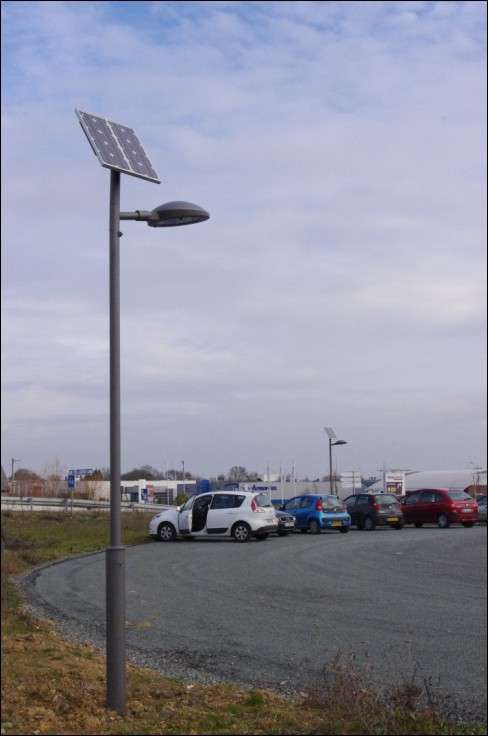
The "NV2" streetlamp was chosen for its directional lighting, lighting level and understated aesthetics. This stand-alone streetlamp with presence detection enables the intelligent management of lighting and reduced light pollution.
The simple installation requires no trench, no wiring, no network connection. A simple ground anchors is required
That is pretty awesome i wish i lived somewhere with a night sky like that, the only cool thing ive seen in the sky is the aurora borealis and that
rarely happens where i live. Michigans night sky sucks
Makes the main page at APOD today.


Sweeping from the eastern to western horizon, this 360 degree panorama follows the band of zodiacal light along the solar system's ecliptic plane.
Dust scattering sunlight produces the faint zodiacal glow that spans this fundamental coordinate plane of the celestial sphere, corresponding to the apparent yearly path of the Sun through the sky and the plane of Earth's orbit. The fascinating panorama is a mosaic of images taken from dusk to dawn over the course of a single night at two different locations on Mauna Kea.
The lights of Hilo, Hawaii are on the eastern (left) horizon, with the Subaru and twin Keck telescope structures near the western horizon. On that well chosen moonless night, Venus was shining as the morning star just above the eastern horizon, and Saturn was close to opposition. In fact, Saturn is seen immersed in a brightening of the zodiacal band known as the gegenschein.
The gegenschein also lies near 180 degrees in elongation or angular distance from the Sun along the ecliptic. In the mosaic projection, the plane of our Milky Way Galaxy runs at an angle, crossing the horizontal band of zodiacal light above the two horizons. Nebulae, stars, and dust clouds of the bulging galactic center are rising in the east.
new topics
-
whistleblower Captain Bill Uhouse on the Kingman UFO recovery
Aliens and UFOs: 4 hours ago -
1980s Arcade
General Chit Chat: 7 hours ago -
Deadpool and Wolverine
Movies: 7 hours ago -
Teenager makes chess history becoming the youngest challenger for the world championship crown
Other Current Events: 8 hours ago -
CIA botched its handling of sexual assault allegations, House intel report says
Breaking Alternative News: 9 hours ago
top topics
-
Lawsuit Seeks to ‘Ban the Jab’ in Florida
Diseases and Pandemics: 12 hours ago, 20 flags -
Starburst galaxy M82 - Webb Vs Hubble
Space Exploration: 14 hours ago, 13 flags -
The Superstition of Full Moons Filling Hospitals Turns Out To Be True!
Medical Issues & Conspiracies: 16 hours ago, 8 flags -
CIA botched its handling of sexual assault allegations, House intel report says
Breaking Alternative News: 9 hours ago, 8 flags -
15 Unhealthiest Sodas On The Market
Health & Wellness: 14 hours ago, 6 flags -
whistleblower Captain Bill Uhouse on the Kingman UFO recovery
Aliens and UFOs: 4 hours ago, 6 flags -
1980s Arcade
General Chit Chat: 7 hours ago, 4 flags -
Teenager makes chess history becoming the youngest challenger for the world championship crown
Other Current Events: 8 hours ago, 3 flags -
Deadpool and Wolverine
Movies: 7 hours ago, 3 flags
active topics
-
Lawsuit Seeks to ‘Ban the Jab’ in Florida
Diseases and Pandemics • 22 • : Disgusted123 -
Definitive 9.11 Pentagon EVIDENCE.
9/11 Conspiracies • 421 • : Lazy88 -
1980s Arcade
General Chit Chat • 8 • : F2d5thCavv2 -
What is a dream
The Gray Area • 27 • : wrayth -
Europe declares war on Russia?
World War Three • 61 • : F2d5thCavv2 -
The Acronym Game .. Pt.3
General Chit Chat • 7741 • : F2d5thCavv2 -
Russia Ukraine Update Thread - part 3
World War Three • 5713 • : F2d5thCavv2 -
IDF Intel Chief Resigns Over Hamas attack
Middle East Issues • 32 • : Terpene -
15 Unhealthiest Sodas On The Market
Health & Wellness • 32 • : VariedcodeSole -
Fast Moving Disc Shaped UFO Captured on Camera During Flight from Florida to New York City
Aliens and UFOs • 18 • : inflaymes69
35
